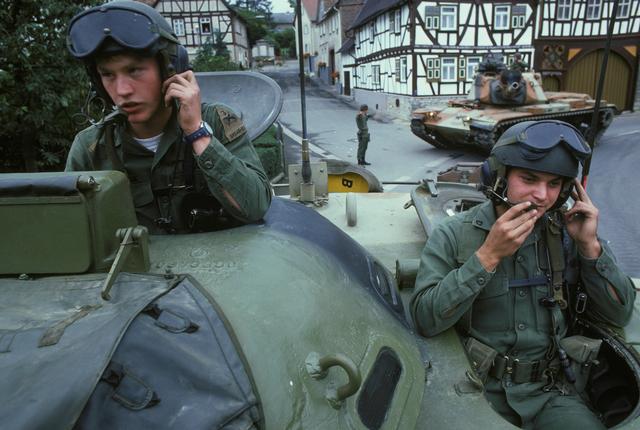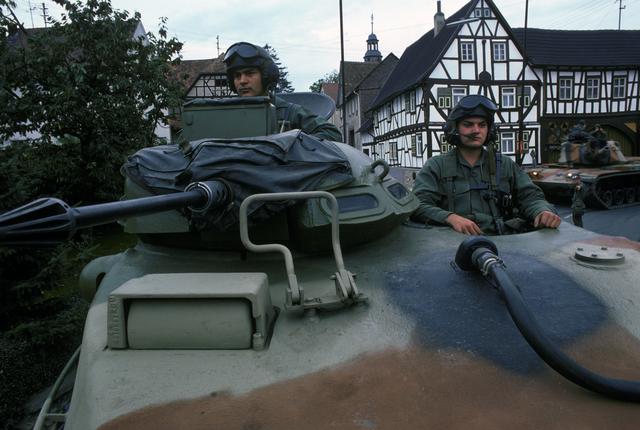Hmmm...big question with many answers. I can’t recommend any books for that particular timeframe— maybe Osprey has one? But as an Armor Officer serving in Germany in the 70s, I can tell you what we wore— the same basic uniform as everyone else. In the vehicle, tankers coveralls were common, these were a basic green one-piece coverall—step in and button down the front— the same worn by mechanics, always worn over the fatigue uniform. There was a cold weather variation that was heavier, a darker green with a zipper down the front. There were other items that could be found, but not necessarily particular only to tankers:
CVC helmets
Over-the-shoulder holsters for the .45
Tanker Jackets (Mostly found in CAV units)— locally made from shelter halves Tanker Boots (non-standard issue locally made or made to order)
Most armored units issued “Tank Crew Qualification“ patches that were displayed on the right pocket of the field jacket or tankers jacket for crews who had successfully gone through qualifications. And of course the unit and combat patches could be found on the shoulders. Ranks were displayed in black (or brown for Majors and 2LTs) on the collars and cap/beret/helmet cover either “pin-on” or “sew on” types. (I have a funny story about that). Sew on tapes displaying “US ARMY” above the left jacket/uniform upper pocket and the individuals name above the right— not necessarily found on coveralls or wet weather gear.
Because they were locally made, a tankers jacket could vary in detail, but they were basically a short waisted cut with a slanted hand pocket on either side (think of a windbreaker) with no collar or a soft flex collar that zipped all the way up to the neck. The waist was usually a soft flex “stretch” type. They were commonly lined with a camouflage poncho liner, or the liner for the cold weather jacket. For winter, many troops also modified ponchos and shelter halves into a longer waterproof coat, or used their issued -wet weather gear.
For the most part, armored units were issued the same cold weather and warm weather gear as the rest of the US Army, along with the same green Fatigue Uniform, Black boots and Field Jacket. Some units (like the 11th ACR) wore black berets, but that was non-standard for the rest of the army (except ranger and SF units). In the latter years of Vietnam, Stetson hats became popular for many Air Cav units.
I had a tankers jacket that I wore primarily in garrison, or sometime in the field if I was riding in a 1/4 ton as in doing an evaluation or acting as an umpire. I wore my coveralls in the tank over my fatigue uniform. If it was wet/cold, I’d wear my specially made “poncho-jacket”- a long jacket I had made by the base tailor out of my issue poncho that resembled a field jacket without the pockets, lined with a blanket, and had buttons around the collar for attaching the “cold weather hood”— this was a hood for the issue extra long cold weather parka, which had a fur fringe. Uniforms varied a lot more in the winter than in the summer, when most of us wore just the coveralls, sleeves rolled up or rolled down depending on conditions. Usually, sleeves rolled was a unit directive.
All the “tailor made gear” was optionally purchased and made by the base tailor, or available through the “US Cavalry Store” in Kentucky ( right outside Fort Knox) via mail order. Tankers boots were commonly purchased that way, but, some base tailors were also “boot repair” outlets, and could modify boots to suit. A tankers boot used a zipper or flap rather than laces, and could vary to individual taste. Some had a flap with a long securing strap to wrap around the ankle. I had a simple zipper installed in my service boots on the outside on an angle. I also had Vibram soles added— heavy lugged for traction. The common issue boot was black leather lace up with a flat leather sole and rubber heel. It was lousy for winter traction.
I was in the 11th ACR from 1976-1980, but went through basic trading and saw variations of most of the stuff above from 1974 onward. By 1980, a lot of this “optional” stuff was being suppressed in Germany, and it was all gone by 1983 with the exception maybe of the cold weather gear. Hope this helps a bit.
It might help if you had a specific unit and weather condition in mind.
VR, Russ




























